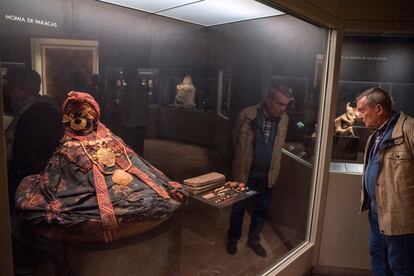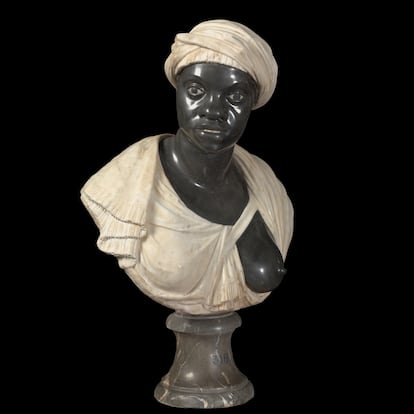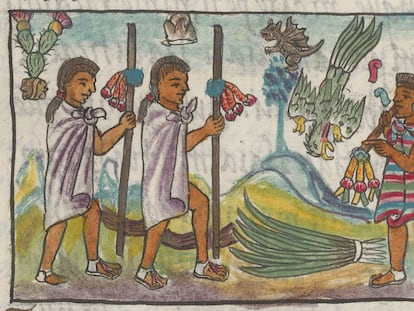Decolonizing the museum: beyond victims and villains
Debates focused on myths of good and evil have little to do with a practice that has been happening for years in the world’s most prestigious institutions

The National Gallery in London is dedicating one of its temporary exhibitions to The Lavergne Family Breakfast by Swiss painter Jean-Étienne Liotard, displaying both the original pastel version (1754) and its oil equivalent (1773) to document the creative process of one of the artist’s most renowned works. In addition to the virtuosity and beauty of the paintings, the pieces also highlight the contradictions of 18th-century society. Several placards that accompany the exhibition describe the painter’s passion for Japanese porcelain. One of them notes: “The sophisticated elegance of these luxury tableware obscures the fact that coffee, sugar and chocolate were produced by slaves in Europe’s American and Caribbean colonies. No doubt Liotard, his clients and his models were aware of these facts.” The placard offers a representative example of museum discourse adopting a decolonial practice: offering the visitor factual information about the historical context that accompanies a work, in an account based on contrasted documentary sources, not opinions.
Museum policies regarding decolonization are connected to concrete theories and practices that are far removed from the tug-of-war over myths of good and evil. Debates about colonization and defenses of, and attacks against, Europe’s imperial past, are plagued by simplistic historical reductions, more typical of biased pundits than knowledgeable specialists. Unfortunately, there have been some embarrassing statements made in recent days that lead me to believe that we historians have failed to explain our past, our better moments as well as our darkest shadows.
Debates for or against the conquest of the Americas, about “victims and villains,” have nothing to do with the practice of decolonizing museums. Decolonizing a museum is not about perpetuating narratives about who was better or worse, about whether Spaniards were kinder or fairer toward the original populations than the British, about compensating Latin American countries for the extraction of gold and silver or about asking for forgiveness for violent acts from the past. To focus on these questions is a mistake, and it confuses the public’s perceptions of the true meaning behind a museum practice that has been developed over years at the world’s most prestigious institutions. It would not be a bad idea for Spain to work harder to modernize its national story, despite the imperial, outdated and tiresome fanatical commitments of some.
So, what does it mean to decolonize a museum? It’s not about rewriting the past, but about explaining it more, and better. It means promoting actions that aim to change the paradigm when it comes to exhibiting collections that are held, with such pride and professionalism, in our museums. It means offering a reflection on the discursive architecture of the objects exhibited, to give these pieces new meaning, and to confer value on others. It means giving a voice to subaltern groups and challenging linear understandings of colonialism. It means adapting our explanations to the current reality of society, which in the case of Spain is more dynamic and heterogeneous, and quite different from what it was decades ago. It means opening up our advisory committees to other visions, to other groups that can collaborate in suggesting exhibitions or rethinking perspectives. In short, it means resisting the mummification of museums and transforming them into places more in tune with the present.
A collection created in the 19th or early 20th century cannot have the same parameters as one we might organize today. But any renovation policy requires funding to realize its goals, otherwise we would be stuck with nothing but words and furious and biased arguments. I would hope that the Minister of Culture understands that good ideas are easier to implement with generous budgets, because, after all, museums are excellent publicity for the nation’s reputation. Funding museums is investing in a product that attracts hundreds of thousands of visitors to the country.
Let’s not forget that tourists expect innovative museums, and that these cultural institutions represent a significant source of national income. It would be very myopic to oppose this effort to rearticulate these spaces, when we have such a diverse and multiethnic public. We should also clarify that while the integration of decolonial policies in private museums has been quite successful, due in part to these institutions enjoying greater autonomy in hiring and agility in implementation, this does not negate the professionalization and capacity for hard work and innovation of the teams and technicians who operate public museums in this country.
In the Prado Museum in Madrid, we are now able to appreciate more and more works and exhibitions created by women, something that was unthinkable just a few years ago; indeed, the beautiful lion El Cid (1879), by Rosa Bonheur, was exhibited there quite recently. I wonder how many works produced in the Americas during the reign of the Habsburgs or the Bourbons are exhibited in its halls. Is it that their workmanship or quality are not worthy of display? Why can’t an ángel arcabucero from the Quito School share space with Spanish or European artists? Why can we delight in a table of hard stones but not stop to fix our gaze on a Michoacán batea from the period of the viceroyalty? Choosing to exhibit pieces from the Americas is also a decolonial exercise.

The Prado Museum, which is making an effort to rewrite its exhibition placards and website text, tends to cede American-themed works to institutions like the Museo de América, perhaps operating under the belief that a monographic museum will bring them more value. In any case, it would be nice to see some of these works exhibited in its permanent collection, understanding that this can often entail difficulties. Another action that could help to further the policy would be to incorporate detailed explanations of certain pieces. For example: the sculpture Una etíope (17th century, room 92) could add more detailed text describing what the slave system meant for humanity and explaining that Spain, along with Brazil, was the last country to definitively abolish slavery in 1886. We cannot fall back on foreign references to describe American phenomena, or portray mestizaje as a simple process of population whitening. Museums cannot serve as places of racialized memory, and should avoid uncritical narratives. I have no doubt that the directors of Spanish museums know how to best address these challenges posed by modernization.
Sign up for our weekly newsletter to get more English-language news coverage from EL PAÍS USA Edition
Tu suscripción se está usando en otro dispositivo
¿Quieres añadir otro usuario a tu suscripción?
Si continúas leyendo en este dispositivo, no se podrá leer en el otro.
FlechaTu suscripción se está usando en otro dispositivo y solo puedes acceder a EL PAÍS desde un dispositivo a la vez.
Si quieres compartir tu cuenta, cambia tu suscripción a la modalidad Premium, así podrás añadir otro usuario. Cada uno accederá con su propia cuenta de email, lo que os permitirá personalizar vuestra experiencia en EL PAÍS.
¿Tienes una suscripción de empresa? Accede aquí para contratar más cuentas.
En el caso de no saber quién está usando tu cuenta, te recomendamos cambiar tu contraseña aquí.
Si decides continuar compartiendo tu cuenta, este mensaje se mostrará en tu dispositivo y en el de la otra persona que está usando tu cuenta de forma indefinida, afectando a tu experiencia de lectura. Puedes consultar aquí los términos y condiciones de la suscripción digital.
More information
Archived In
Últimas noticias
Venezuela hardens its ‘revolutionary state’ project amid pressure from Trump
Sydney Sweeney, the actress praised by Trump: ‘Women are up against what society wants them to be’
The Bolsonaro surname: An advantage or liability in Brazil’s 2026 presidential elections?
Raúl Rocha, from jet-setting with Miss Universe to arms trafficking and fuel theft
Most viewed
- Reinhard Genzel, Nobel laureate in physics: ‘One-minute videos will never give you the truth’
- Pablo Escobar’s hippos: A serious environmental problem, 40 years on
- Charles Dubouloz, mountaineering star, retires at 36 with a farewell tour inspired by Walter Bonatti
- Why we lost the habit of sleeping in two segments and how that changed our sense of time
- The fall of a prolific science journal exposes the billion-dollar profits of scientific publishing










































